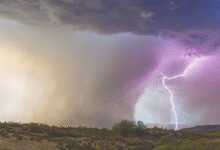What Scientists Say About Near-Death Experiences (It’s Weirder Than You Think)
Near-death experiences (NDEs) revealed. Scientists out-of-body vision and startling evidence that challenges our understanding of consciousnes.

Near-death experiences (NDEs) have long captivated both scientists and the general public, blurring the lines between science, spirituality, and the unknown. These extraordinary events occur when individuals come close to death often during cardiac arrest, traumatic accidents, or severe illness only to return with vivid accounts of floating outside their bodies, moving through tunnels of light, or encountering deceased loved ones. While skeptics dismiss them as hallucinations or brain malfunctions, mounting scientific research suggests that Near-Death Experiences may hold clues about consciousness, brain function, and even the possibility of life after death.
What makes near-death experiences so baffling is their consistency across cultures and medical conditions. People from different backgrounds regardless of age, religion, or prior beliefs report strikingly similar sensations, including overwhelming peace, a life review, and a reluctance to return to their bodies. Neuroscientists are now exploring whether these experiences are caused by oxygen deprivation, DMT release, or undiscovered brain mechanisms, while others argue they might point to something beyond biology. As research advances, one thing is clear Near-Death Experiences challenge everything we think we know about death and life itself.
What Scientists Say About Near-Death Experiences
The Science Behind Near-Death Experiences
NDEs are not a new phenomenon, but modern science is finally taking them seriously. Studies show that about 10-20% of cardiac arrest survivors report vivid NDEs, often describing similar elements: a tunnel of light, a sense of peace, and encounters with spiritual beings. Researchers believe these experiences may be linked to reduced oxygen flow or a surge in neurochemical activity as the brain shuts down. One leading theory suggests that the brain releases dimethyltryptamine (DMT), a powerful psychedelic compound, during traumatic events. Dr. Rick Strassman’s research proposes that DMT could induce mystical experiences, explaining the surreal visions reported in NDEs.
Out-of-Body Experiences
One of the most compelling aspects of Near-Death Experiences is the out-of-body experience (OBE), where individuals claim to observe their own bodies from above. In some cases, patients have accurately described medical procedures they shouldn’t have been able to see. The AWARE study, led by Dr. Sam Parnia, investigated OBEs during cardiac arrest and found a few verifiable cases where patients recalled events that occurred while they were clinically dead. Neuroscientists explain OBEs as a result of temporal lobe dysfunction or disruptions in the brain’s angular gyrus, which governs spatial awareness. Yet, the precision of some accounts remains unexplained. If consciousness can exist independently of the brain, as some researchers speculate, it could revolutionize our understanding of human consciousness.
The Role of the Dying Brain
When the brain is deprived of oxygen, it enters a state of hyperactivity, firing neurons in rapid succession. This phenomenon, known as “terminal lucidity,” might explain the vivid hallucinations and life reviews reported in Near-Death Experiences. Some scientists compare it to a “reboot” sequence, where the brain replays memories and sensory inputs in a last-ditch effort to survive. However, not all NDEs occur during clinical death. Some people report similar experiences during extreme stress or meditation, suggesting that the brain has an innate ability to produce transcendental states under certain conditions. This raises the question Are NDEs purely biological, or do they hint at something beyond physical existence?
Cultural and Psychological Influences
Cultural Framing Shapes Interpretation
While the core Near-Death Experiences remains remarkably consistent globally, cultural background heavily influences how individuals interpret their journey. Westerners often describe meeting religious figures like Jesus, while Hindus report encounters with Yamraj (the death god), proving our beliefs create the symbolic language of these experiences.
Psychological Filters Alter Recall
Memory reconstruction plays a key role studies show trauma survivors may emphasize different aspects than those facing sudden accidents. The brain instinctively weaves Personal History and emotional state into the Near-Death Experiences narrative, making each account uniquely filtered through individual psychology.
Expectation Shapes the Experience
Those raised with strong afterlife beliefs often report more detailed visions matching their faith, while skeptics sometimes describe more abstract encounters. This suggests the mind may use familiar concepts to process the incomprehensible nature of near-death states.
Universal Core Beneath Cultural Variations
Despite these differences, the profound feelings of peace, life review, and reluctance to return remain consistent across all accounts. This striking commonality suggests these experiences tap into something fundamental about human consciousness beyond cultural programming.
The Nature vs Nurture Debate Continues
Researchers remain divided whether cultural influences prove NDEs are purely subjective, or simply demonstrate how humans translate an objective transcendent experience into personal understanding through existing mental frameworks.
Could NDEs Prove the Afterlife?
Verifiable Out-of-Body Experiences Challenge Science
Some NDE accounts include precise, medically confirmed details of events that occurred while patients were clinically dead with no brain activity. These verified perceptions like accurately describing surgical procedures or hidden objects defy conventional neurological explanations, suggesting consciousness might operate beyond the physical brain.
Shared Core Experiences Across Cultures
Despite varying cultural interpretations, NDEs consistently feature universal elements: life reviews, encounters with beings of light, and overwhelming peace. This remarkable consistency across ages, religions, and societies hints at a possible objective reality behind these experiences rather than just brain-generated hallucinations.
Transformational Effects Defy Psychological Explanations
NDE survivors often display permanent, measurable changes in personality, brain function, and belief systems. Many lose their fear of death entirely and develop enhanced intuition – changes so profound that researchers struggle to explain them through normal psychological processes alone.
The Consciousness Continuation Debate
While skeptics attribute NDEs to oxygen deprivation or DMT release, these explanations fail to account for the structured, lucid narratives and life-altering impacts. The unresolved question remains: If consciousness can exist independent of brain activity, does this suggest survival after bodily death?
The Scientific Community Remains Divided
Leading researchers are split between biological explanations and more radical theories of extended consciousness. Until technology can measure consciousness beyond clinical death, NDEs will remain one of science’s most fascinating unsolved mysteries about the nature of existence itself.
Read More: The Most Mysterious Unsolved Crimes of the Last Decade
Conclusion
Near-death experiences (NDEs) continue to challenge our fundamental understanding of consciousness and what happens when we die. While scientific research has uncovered potential explanations involving brain chemistry and neural activity, the profound, life-changing nature of these experiences suggests there may be more to them than mere biological processes. The consistency of NDE accounts across cultures despite varying interpretations hints at something deeper, something that science has yet to fully explain.
As technology and neuroscience advance, we may come closer to unraveling the mystery of near-death experiences. Whether they ultimately prove to be glimpses of an afterlife, the brain’s final surge of activity, or something beyond our current comprehension, NDEs undeniably transform those who experience them. They force us to question the boundaries between life and death, science and spirituality, leaving us with one haunting possibility.
FAQs
What exactly is a near-death experience (NDE)?
An NDE is a profound psychological event that may occur when a person is close to death or in a life-threatening situation, often featuring out-of-body sensations, bright lights, and life reviews.
Are near-death experiences scientifically proven?
While NDEs are well-documented, their cause remains debated – studies suggest brain chemistry plays a role, but some cases challenge purely biological explanations.
Do all people experience the same thing during NDEs?
Core elements like peace and light are common across cultures, but specific details (like religious figures) often reflect personal beliefs and background.
Can near-death experiences change a person’s personality?
Many report lasting transformations including reduced fear of death, increased empathy, and greater spirituality following their experience.
Could NDEs be evidence of an afterlife?
While intriguing, current science can’t confirm this – they may represent unknown brain functions or, as some researchers suggest, something beyond physical explanation.











